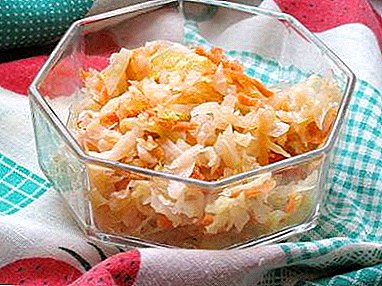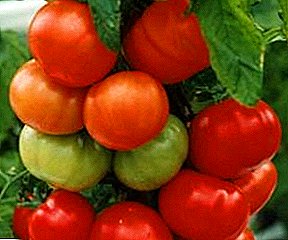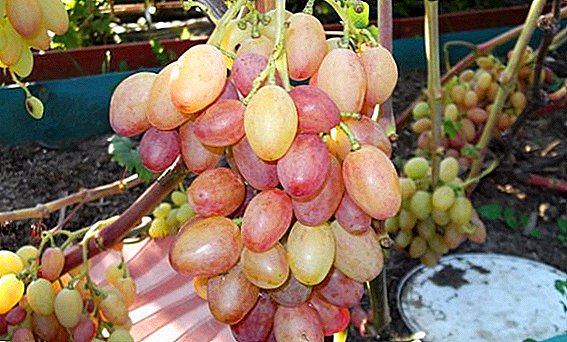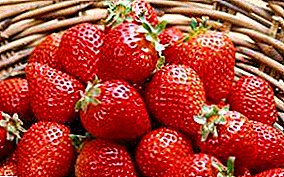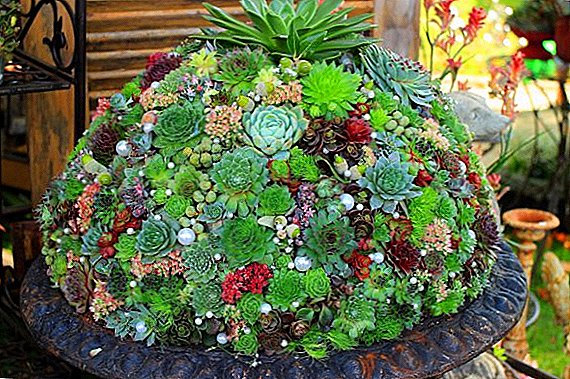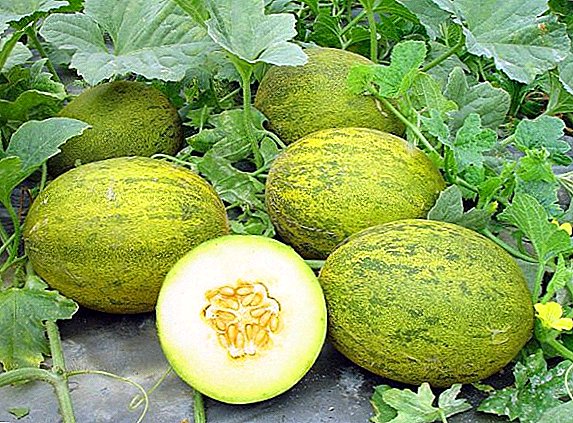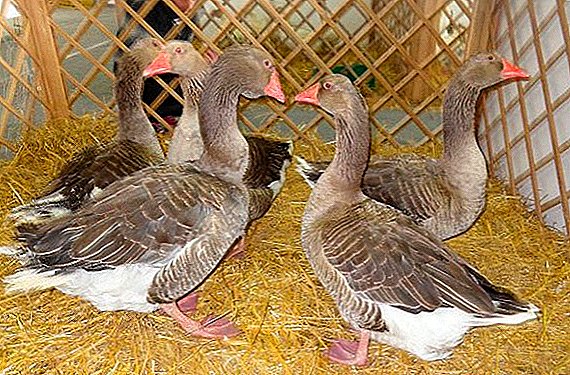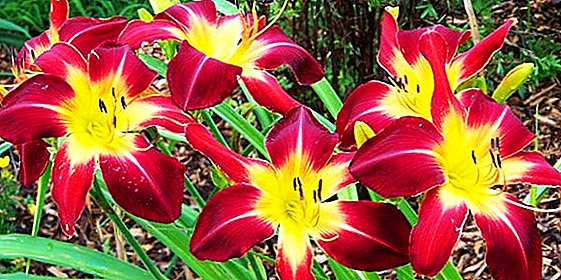 The popularity of daylilies is unshakable, which is absolutely not surprising. After all, the bright color of the buds, smooth transitions of delicate shades, the unique variety of aromas and ease of care can not leave indifferent flower lovers. In the world, these amazing perennials, according to the American Daylily Society (ANS), are 80,000 varieties that will satisfy even the most capricious floral aesthetes. For a general presentation, let us dwell on the features of grouping flowers of the daylily.
The popularity of daylilies is unshakable, which is absolutely not surprising. After all, the bright color of the buds, smooth transitions of delicate shades, the unique variety of aromas and ease of care can not leave indifferent flower lovers. In the world, these amazing perennials, according to the American Daylily Society (ANS), are 80,000 varieties that will satisfy even the most capricious floral aesthetes. For a general presentation, let us dwell on the features of grouping flowers of the daylily.
Daylily classification
The entire decorative potential of daylilies (Hemerocallis) was able to be shown to members of the ANS community, who have been the official registrar of these plants for 71 years.  In general, their classification distinguishes 2 types: species and varietal. We will understand in more detail.
In general, their classification distinguishes 2 types: species and varietal. We will understand in more detail.
Did you know? In daily life, the daylily due to long flowering and undemanding of the soil, the cultivation conditions are called "flower for lazy gardeners."
Species
Despite the diversity of daylilies of hybrid varieties, in nature there are only 6 of their main types:
- Hemerocallis fulva. Very common on all continents. In some areas of temperate climatic zones, it can be seen in its wild form. Externally, it is a tall shrubby plant with narrow and long drooping leaves and bright large flowers. They rise on thin peduncles and are characterized by yellow-brown petals and a rich yellow core.
- Hemerocallis lilioasphodelus. The species was cultivated around the XYI century. Often found in landscape gardening areas of Europe and the Far Eastern countries. Differs from its counterparts fragrant bright yellow petals, the length of which is about 6-7 cm.
- Hemerocallis citrina. Wild daylilies of this species are found in China. Their feature is in the night bloom. Bright lemon petals, which are up to 15 cm long, have a very strong aroma. Flowers never fully open.
- Hemerocallis minor. This type of daylilies is habitual for residents of the Far East, China, Mongolia, where it is found everywhere. The plant blooms monotonous solar buds, which are 6-7 pieces in a brush.
- Hemerocallis thunbergii. It is often confused with the already mentioned hemerocallis citrina, which is due to a certain similarity of tender yellow inflorescences. But the main difference is that the Thunberg daylily gives off a faint fragrance, and the flowers open in the afternoon.
- Hemerocallis middendorffii. The species range in the Far East. Outwardly, these are beautiful rich yellow buds, in which there are about a dozen buds. In addition, the species has a very early flowering.






Important! Excessively wet substrate and stagnant water have a detrimental effect on daylilies.
Varietal
A characteristic feature of this type of daylilies, which in the specialized literature is referred to as Hemerocallis hybrida hortulorum, is its artificial origin when pollinating different natural varieties and breeding varieties.
Today, the American Society of the Daylily has registered 35 thousand of its varieties. Basically, they all enter the flowering phase from the beginning to the end of summer.  And the width of the color spectrum of varieties is amazing. Depending on the genetic ploidy, there is a selection with a more pronounced color or, on the contrary, with a muted tonality.
And the width of the color spectrum of varieties is amazing. Depending on the genetic ploidy, there is a selection with a more pronounced color or, on the contrary, with a muted tonality.
It is characteristic that scientists have moved far from the natural specific colors, creating two-colored and multi-colored varieties. Blends are considered the best varieties of hybrid daylilies.
They are multi-ton, reverse petals with smooth transitions, specks or stripes. An example of such a masterpiece is Polich costeil.
Did you know? The pioneer of indefinite forms of daylilies was A. B. Stout, who in 1929 created a hybrid "Wau-bun". Unfortunately, this creation did not fall into the official register of "unusual forms". It opened only in 1933 "Taruga".
How to divide the daylilies
If you think that all daylilies, like a selection, have the same bush form, the length of leaves and peduncles, and differ only in the coloring of the petals and the peculiarity of flowering, you are deeply mistaken.  In the world there are many classifications of these wonderful plants. And the more nerds analyze the difference between them, the more groups appear.
In the world there are many classifications of these wonderful plants. And the more nerds analyze the difference between them, the more groups appear.
According to the height of peduncles
As you already understood, not all flower stalks of daylilies are the same. In the wild, you can find specimens with half-meter and two-meter floral arrows. In the scientific literature, focusing on their length, share:
- undersized perennialswhich extend up to a maximum of 60 cm, moreover, that they are not lower than 30 cm;
- medium tall - reach 90 cm:
- tall - unite all daylilies, flower stalks which are above 90 cm.
The shape and size of the flower
Analyzing the descriptions of all types and varieties of daylilies in terms of the size and shape of the inflorescences, Scientists have identified 4 main groups.
Namely:
Did you know? All daylilies can grow safely in one place for more than a decade.
- Terry. Flowers with such petals look very impressive and elegant. The splendor of the inflorescences is explained by the wavy border and the internal additional petal row. Moreover, the density of the terry may be equated, for example, with pions or kerii. There are cases when the plant loses its flounces in adverse cold conditions of cultivation.
- Arachnids. The peculiarity of this form lies in the length of the petals prevailing over the width. The approximate ratio of these parameters is as follows: 0.5 - 1/4 - 5 cm. The largest inflorescences of the daylilies are considered arachnids. They are called "spiders" and very often collect avid flower growers. Breeders, whose efforts have already cultivated varieties with terry, multicolored, jagged and wonderfully twisted petals, warm up this interest.
- Indefinite. The daylilies, which have much in common with "spiders", have fallen into this exotic group, but at the same time their petals are much wider than those of the classical arachnid. In addition, the flowers often resemble any shape, which is the main uniqueness of this variety.
- Polymers. They are breeding works that have not 6 petals, like all the other daylilies, but 8-12. It is impossible to confuse this group with terry, since polymers have one petal row. Flowers with perfectly round, triangular and star-shaped forms are also credited here.




Important! Attacking thrips, slugs, mosquitoes and voles pose a threat to daylilies.
By vegetation types
Judging by the developmental characteristics, the plants were classified into dormant, evergreen and semi-evergreen. Consider the specifics of each group.
- Dormant - the so-called sleeping daylilies shed their leaves in the fall. In winter, they are in a state of calm. And only in spring they awaken from hibernation, triggering a mechanism of intensive development. Under conditions of temperate climatic zones, this kind of culture easily endures harsh winters; therefore, it is found in many private gardens and public parks. In catalogs, this group of colors is indicated by "Dor".
- Evergreen - The evergreen group is widely represented in warm countries. It is there that one can observe the continuous flowering of daylilies. They hibernation lasts for 14 days. If a similar species is planted in the Ukrainian area, the flower will feel good all summer and autumn, its foliage will turn green until winter. But to endure the frost can not. New sprouts from the dead plants can make their way in the spring. In the flower catalogs, the group is marked with the "Ev" icon.
- Semievergreen - These are unique daylilies that have an excellent ability to adapt to any climatic conditions. In winter, they do not stop growing, although they lose their leaves. And in warm countries continue to develop year-round. The group is designated "Sev".



Important! If you are planting daylilies in the fall, be sure to cover the young exotus with fallen leaves, humus, or simply sprinkle on the rhizome a layer of ordinary earth up to 10-15 cm thick. This is done in order to protect the culture from the harsh winter frost. Strong plants do not need such events.
By flowering time
Focusing on the difference in time and timing of daylily blooms, many gardeners specially select varieties for their plot so that the flower bed will be in bright color throughout the summer and autumn.
Depending on the timing of the appearance of flowers on these perennials there are several conditional types:
- Ultra early. These are very rare varieties. Flowers appear on them in the period from May 20 to June 6. The group is represented by varieties "Royal Sovereign", "Queen of May", "George Weld".
- Early. Blossom from July 10 to 25. Presented "Angel Mine", "Step Forward", "Derby Bound", "Bourbon Kings", "Lady Inara", "Minstrel Boy".
- Averages, which are "Anna Warner", "Windsor Castle", "Carnival Flair", "Tracy Hall", "Chipper Cherry", "Peach Pinwheel", "Christmas Carol", "Master Touch", "Country Club", " Missouri Beauty. " Buds on them are disclosed in the period from 20 to 30 July.
- Late daylilieswhich include "Heirloom Lace", "Winnie the Pooh", "Lively Set". Begin to bloom in late summer.
Domestic botanists do not recognize this point of view, arguing that the amplitude is too stretched. The only thing in which the thoughts of experts agree, the earlier the plant enters the budding phase, the less it lasts.
Did you know? In Chinese medicine, daylilies are honored as a diuretic and fortifying agent. In the specialized literature of ancient doctors you can find recipes for treatment with the help of the flowers of this culture from the yellowed epidermis, liver diseases and even from anguish.
By flowering time
In the special literature on flowers, catalogs, one can often find incomprehensible Latin letters and letter combinations. In fact, to understand their meaning is easy even for beginners.
We are talking about types of daylilies, depending on the timing of budding. Indeed, in our latitudes, they cannot bloom all year round.  In general, gardeners can see the bloom of this culture from late May to late autumn.
In general, gardeners can see the bloom of this culture from late May to late autumn.
But scientists look at it a little differently, highlighting:
- E - early varieties in which the first flowers appear already in late spring - early summer;
- EAT - mid-early, flowering stage which begins with the last weeks of June - the first half of July;
- M - medium, they bloom with lush tassels in the middle of summer;
- ML - Middle-day lily that opens the buds in the last weeks of July until the middle of August;
- L - later, in which flowers appear only in the second half of August or in early September;
- VL - very late, their budding begins around mid-September (in our latitudes, such varieties are rare, because in unfavorable weather they do not always have time to bloom);
- Re - remontant varieties, which, after the main budding and a few weeks of dormancy, again release the peduncle.
Did you know? Translated from the Greek day lily means "the beauty of the day", which is entirely justified - the flower of this culture lives only 1 day.
Features of growing
All daylilies are very unpretentious, give a lot of fun and do not require much attention. To grow them, it is enough to follow a moderately moist soil, since dryness and excessive moisture in the ground will ruin the flower.  For his landing fit sunny or semi-shaded area with a neutral or slightly oxidized soil.
For his landing fit sunny or semi-shaded area with a neutral or slightly oxidized soil.
In the future, the culture may need additional feeding, the number of which depends on the soil composition.
First This event is usually done in the spring at the beginning of the growing season, and second time - a month after flowering. Experienced daylily lovers are advised to use Kemira Plus special purchased mineral complexes for this purpose.
Fertilizers that will help you in the cultivation of plants: wood ash, mineral and potash fertilizers, biohumus, peat, nitrogen fertilizers.After fertilization, the bush must be watered abundantly.
 Culture can be propagated by cutting, dividing the bush or cutting off the air outlet on the stems, which has already managed to form roots.
Culture can be propagated by cutting, dividing the bush or cutting off the air outlet on the stems, which has already managed to form roots.Professionals manage to get new plants, activating the sleeping buds of bushes. In the garden daylilies are well combined with other flowering plants.
Very often they are used as a background for the facade. At the same time, matching colors are selected.
The orchid, common heather, petunia, brugmansia, sea buckthorn, geykhera, ageratum, rose, and pelargonium also multiply by cuttings.For example, terracotta, yellow, red and orange flowers look great on a light wall, and all the delicate shades look on the dark wall.
Such a plant is able to decorate your day with a variety of its inflorescences. No wonder that in Europe they say that you can enjoy daylilies for a whole summer without doing anything.


